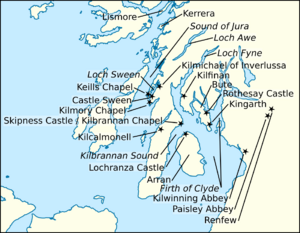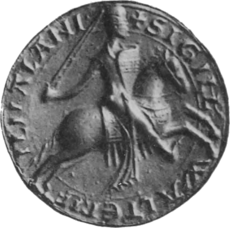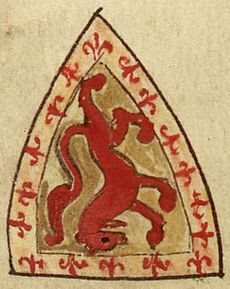Dubhghall mac Suibhne facts for kids
Quick facts for kids
Dubhghall mac Suibhne
|
|
|---|---|
| Noble family | Clann Suibhne |
| Spouse(s) |
|
| Father | Suibhne mac Duinn Shléibhe |
Dubhghall mac Suibhne lived in Scotland during the 1200s. He was an important landholder in a region called Argyll. Dubhghall was a key leader of a powerful family known as Clann Suibhne. His father was Suibhne mac Duinn Shléibhe. Dubhghall likely ruled the area of Knapdale from the 1240s to the 1260s. He might have even started building famous castles like Skipness Castle and Lochranza Castle.
During Dubhghall's time, his family, Clann Suibhne, faced challenges from the Stewarts. The Stewarts were one of Scotland's strongest families. By the 1240s, the Stewarts controlled areas like the Firth of Clyde and Cowal. At the same time, Alexander II, King of Scotland wanted to expand his royal power into Argyll and the Isles. Dubhghall first appears in history during this time. In 1247, he asked Pope Innocent IV for special protection.
King Alexander II's plan to take over Argyll and the Isles stopped when he died in 1249. But his son, Alexander III, continued the fight in the 1260s. This time, Walter Stewart, Earl of Menteith led the Stewart family's expansion. Records from 1261 and 1262 show that Dubhghall gave up his family's lands to Walter Stewart. We don't know if this happened because of a war. However, some of Dubhghall's relatives didn't want to be ruled by the Stewarts. This is clear from the actions of Dubhghall's nephew, Murchadh Mac Suibhne.
Contents
Dubhghall's Family and Castles
Dubhghall was the son of Suibhne mac Duinn Shléibhe. Suibhne was the ancestor who gave his name to the Clann Suibhne family. An old history book from the 1700s, called the Craignish History, says that Dubhghall's daughter married a member of the Campbell family. This man was also named Dubhghall. Their son, also named Dubhghall, became a known landholder in Argyll.
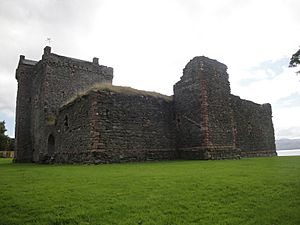
The Clann Suibhne family's lands stretched across Knapdale. They went from the Sound of Jura to Loch Fyne. Their control also reached across the Kilbrannan Sound, from Skipness to Arran.
Dubhghall's father might have built Castle Sween in Knapdale. This castle was built in the late 1100s. It is one of the oldest stone castles still standing in Scotland.
Dubhghall's family also seems to have built Skipness Castle. The first buildings there were likely two separate structures. One was a two-story house with a lord's hall. The other was a small chapel. An earth and timber wall probably surrounded these buildings. The hall house and chapel might have been built in the early 1200s. Skipness Castle is first mentioned in a document from Dubhghall in 1261. This castle might have been a second home. Their main home was probably Castle Sween, which was the center of Clann Suibhne's power.
It's possible that Dubhghall himself started building Skipness Castle. Clann Suibhne, and Dubhghall especially, might have also built Lochranza Castle on Arran. The ruins you see today are from a later tower house. But the original hall house was built in the 1200s or 1300s. If Clann Suibhne built this castle, it means they had strong control over the Kilbrannan Sound.
Scotland's Expansion into Argyll
One of the most powerful Scottish nobles during King Alexander II's rule was Walter fitz Alan II, Steward of Scotland. He was the head of the Stewart kindred. The Stewarts first gained power in an area called Renfrew. By about 1200, Walter fitz Alan's father, Alan fitz Walter, Steward of Scotland, had expanded their control. They moved into the Firth of Clyde and took over the Isle of Bute. Alan gave the church of Kingarth on Bute to Paisley Abbey. This shows their power over the island. The Stewart castle on Bute, Rothesay Castle, was likely built around 1200. This makes it as old as Clann Suibhne's Castle Sween. The Stewarts' expansion can be seen in their gifts to Paisley Abbey. This abbey was founded by their family in the 1100s. Other local families who became part of the Stewart lands also made gifts to the abbey.
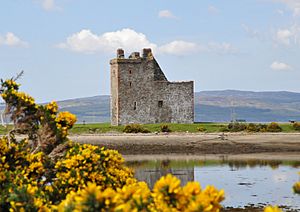
Alan might have also expanded into Cowal. But it's also possible that Walter fitz Alan gained Cowal. Records show that by the time Walter fitz Alan died in 1241, Cowal was under Stewart rule. Scottish royal power was also growing in Argyll. An early sign of this expansion is a gift from Laghmann mac Maoil Choluim. He gave the church of St Finan (Kilfinan) to Paisley Abbey between 1232 and 1241. Laghmann was a close relative of Dubhghall. Dubhghall himself was a witness to this event.
In the 1230s, King Alexander II got involved in church matters in Argyll. In 1236, the Pope told the Bishop of Moray to make sure a new Bishop of Argyll was chosen properly. By 1239, a man from Moray named William became Bishop of Argyll. After William drowned, Clement, Bishop of Dunblane took over. By 1248, the bishop wanted to move the main church from Lismore to the mainland. This was probably at the king's request. The king also gave land around Loch Awe and Loch Fyne to Giolla Easbuig Mac Giolla Chríost. This happened on August 1, 1240. It was the first time land in the western Highlands was given for knight's service.

In 1244, King Alexander II tried to buy the Isles from Norway. The expansion of Scottish royal power might explain why Dubhghall and the monks of Iona asked for protection from the Pope. For example, on April 17, 1247, Pope Innocent IV gave protection to Dubhghall and his lands. A few days later, on April 22, 1247, the Pope also acted to protect the independence of the Islesmen. He told abbots in Scotland not to force the abbot of Iona to attend a Benedictine meeting. On the same day, the Pope also allowed the Abbot of Iona to use a ring and mitre. This was to ensure his church freedom. Earlier, on March 20, 1247, the Pope confirmed a gift from Dubhghall to the church of St Colmán Ela (Kilcalmonell).
In 1248, Haraldr Óláfsson, King of Mann and the Isles, and his new wife, Cecilía Hákonardóttir, were lost at sea. They were sailing from Norway to the Isles. When he heard this sad news, Cecilía's father, Hákon Hákonarson, King of Norway, sent Eóghan Mac Dubhghaill to rule the Isles for a short time. In the summer of 1249, King Alexander II invaded Argyll. He attacked the main lands of the Clann Dubhghaill family. It seems that Eóghan and Alexander II had problems. Also, Haraldr's death caused family disagreements over who would rule next. Eóghan accepting power from King Hákon might have made the Scots attack. During the invasion, Alexander II demanded that Eóghan stop supporting Hákon. He also ordered Eóghan to hand over some castles. Eóghan refused. This crisis only ended when the Scottish king died suddenly in July 1249.
Stewart Control in Argyll

About ten years after King Alexander II died, his son, Alexander III, became an adult. He decided to continue his father's plan to expand into Argyll and the Isles. Again, the Stewarts led the way. This time, it was Walter fitz Alan's son, Walter Stewart, Earl of Menteith. Records from the early 1260s show that Clann Suibhne's lands were being given away.
For example, on April 17, 1261, Dubhghall, with his heir Eóin's agreement, gave the church of St Colmán Ela to Paisley Abbey. He also gave them the chapel of St Columba near Skipness Castle. Dubhghall said he made this gift for his soul and the souls of his ancestors and wives, Juliana and Johanna. He also wanted to be buried at Paisley.
Also, a document from Walter Stewart to Paisley Abbey, dated January 19, 1262, confirmed Dubhghall's gift. It also stated that Dubhghall had already given the lands of Skipness to Walter Stewart himself. Dubhghall is also said to have given Walter Stewart his lands to be held as a "free barony." This meant Walter would provide two-thirds of a knight's service to the king's army. One of these lands was called "duabus Ungyns MacCrunnel." This name matches Dubhghall's title "lord of the land of Macherummel," used in the papal protection document from 1247. More proof of the Stewarts taking over Clann Suibhne's main lands includes Walter Stewart's gifts of several Knapdale churches to Kilwinning Abbey. These churches were St Abbán moccu Corbmaic (Keills Chapel), St Michael (Kilmichael of Inverlussa), and St Mary/St Máel Ruba (Kilmory Chapel).

We don't know the exact reasons for Dubhghall's agreement with Walter Stewart. There are no other records about how Clann Suibhne's lands were divided during this time. We also don't know if the Stewarts or their allies were already in Knapdale.
The events involving Clann Suibhne show that the family slowly lost their lands. We don't know if these documents mean there was a military invasion. The Stewarts gaining power in the region might have been part of Scotland's plan to expand royal authority into Argyll and the Isles. Both the Stewarts and the Scottish Crown likely saw Clann Suibhne as a threat to peace in the area. Getting rid of or weakening families like Clann Suibhne was part of a plan. This plan also aimed to make new alliances with more loyal families, like Clann Dubhghaill and Clann Domhnaill. It also helped loyal supporters of the Scottish Crown, like the Stewarts, gain more power.
Clann Suibhne's power in Knapdale and Kintyre seems to have ended by the 1260s. The Stewarts replaced them. This change of power certainly meant that Scotland had more control in Argyll. It might have also played a part in Eóghan's surprising refusal to help King Hákon against Scotland later that decade. The fact that some members of Clann Suibhne didn't want to be ruled by the Stewarts is shown by Dubhghall's nephew, Murchadh Mac Suibhne, who later supported Norway.
See also
- Eóin Mac Suibhne, a descendant of Dubhghall's nephew, Murchadh, who tried to get back Clann Suibhne's old lands in the 1300s.


